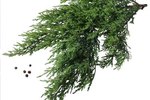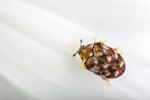Seed moths are a common pest found in birdseed and other seed- or grain-based foods. The presence of a few moths or larvae does not mean the birdseed has gone bad or is inedible. But if not carefully eradicated, a few moths can become an infestation that spreads to your pantry staples within a couple months.
Identifying Seed Moths
Typically, moths found in birdseed are Indian meal moths. Adult moths lay microscopic eggs in the seed, which hatch into larvae. The larvae are 1/4 inch, cream-colored wormlike creatures with brown heads. They feed on the seeds and grains in the bird food. When mature, the larvae spin weblike cocoons around themselves and enter the pupa stage, where they metamorphosize into adult moths. The adults are gray with brown-tipped wings. Adult moths live about one week and do not eat. Females can lay more than 200 eggs in or around accessible food. It takes about seven weeks for the eggs to develop into adult moths.
If you have Indian meal moths, you may see adult moths in the seed container or fluttering around it. You may see larvae, cocooned pupae or the weblike cocoons left behind after the adults emerge in the seed. In more severe infestations, you may find cocooned pupae on the walls or ceiling of the room where you store your bird food. Adult moths can spread to your kitchen leaving larvae or pupae in your pantry items. Larvae can enter thin, flexible sealed plastic packaging by chewing holes through the bag.
Eliminating Moths in Seed
The simplest way to kill the moths, larvae, pupae and eggs in the seed is to seal up the container and freeze your birdseed for at least 48 hours. If you need to repackage it into smaller containers or zip-close bags to fit into your freezer, take the food outside to repackage it to prevent any larvae or adults from escaping the bag into your house. Store it outside on a porch or in the garage and freeze it in batches. Once you've frozen the seed, store it indoors in sealed containers.
Tips
Once you've frozen your seed to kill the moths, it is safe to feed to your bird unless it was so heavily infested the larvae consumed much of the seed. Insects and larvae are a protein source for birds.
Eliminating Moths in Your Home
Vacuum or squish any larvae you see crawling around your seed container or pantry and any pupae from the walls. Throw away any contaminated or unsealed pantry packages containing:
- Flour
- Seeds
- Grains
- Dried fruits and vegetables
- Nuts
- Candies
When in doubt, it is best to throw it out. Put items in the trash outside to prevent any adults or larvae from escaping back into your house.
Vacuum and scrub your cabinets or pantry to ensure eradication of all larvae, pupae and eggs. Pay particular attention to corners, crevices and the undersides of shelves. Toss your vacuum bag or dirt cup contents into the trash outside.
For severe infestations, pheromone traps are effective for catching adult moths. Newly emergent adults often hang upside down under pantry shelves to dry their wings and are easily captured or vacuumed.
Do not use pesticides in your pantry or near your birds. It will have little effect on the moths and may contaminate your food or poison your bird. You can make your own nontoxic concoction to trap and kill the larvae using boric acid and cornmeal.
Preventing Seed Moth Infestations
To keep moths from setting up residence in your home again:
- Always freeze new packages of birdseed for at least 48 hours before storing them in your home.
- Keep all opened pantry items double-bagged in sealed in zip-close bags or in airtight containers.
- Check grains, seeds, nuts and flours periodically for signs of moths.
References
Writer Bio
Kimm Hunt has been writing professionally since 1990. She has written for businesses, government agencies and nonprofit organizations, and previously served as the editor of a weekly suburban Chicago newspaper. Hunt holds a B.S. in agriculture from the University of Illinois. She is also a professional dog trainer.





